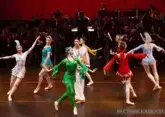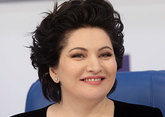In the middle of February 1782, the Shinsho-maru ship with captain Daikokuya Kōdayū from Ise province and 17 sailors left for the city of Yedo from Shiroko. The ship was caught in a storm. Only in next July they landed on the Aleutian Islands after drifting for eight months. It was the start of the difficult journey of Kōdayū and his comrades in Russia. Hungry and cold Kōdayū's people reached Kamchatka, Okhotsk and finally Irkutsk. Six years had passed since the start of their journey, and only five members of the team had survived. Homesickness increased, but they were so far away from home... Kōdayū was granted an audience with Catherine the Great and was permitted to return home with his people. Kōdayū's hope to return to his native land developed into something more - he decided to lay the foundations of friendship between Japan and Russia.
On October 30 and November 1-2, the Kodayu opera performances will be held in Moscow (The Russian Odyssey of Daikokuya Kōdayū), timed to the resumption of relations between Russia and Japan. The story of Kōdayū, who reached the shores of Russia centuries ago and attempted to introduce Russia to the Japanese, remains relevant even now.

The opera was created by composer and violinist Farhang Huseynov at the request of Japanese opera singer Eiko Aoki. Huseynov was born in Baku in 1949. He received his musical education at the Baku and Moscow State Conservatories where his composition teachers were Kara Karaev and Aram Khachaturian, he studied in the violin class where his teachers were Leonid Kogan and Karp Dombaev. In 1975 he was graduated from Moscow State Conservatory and till 1978 he worked with Leonid Kogan as a violin assistant. Then he worked at the Azerbaijan State Conservatory from 1978 to 1992. In 1992, he left for Turkey, where he started to work as a head of the string instruments department of Cukurova University's State Conservatory Adana. He played as a first violinist in the Quartets of Baku and Moscow, and performed in many cities of the former USSR. He was a member of the Moscow Conservatories Orchestra in West Berlin in 1972, and there he won the Gold Medal in the Herbert von Karajan Competition.
.jpg)
Many of his compositions were performed in the former USSR and also in other countries. His Concerto for orchestra named 'Traveling through the Time' won the prize at the International Composition Competition in Tokyo, Japan (1991). This competition was organized by Japanese TV Asahi and supported by UNESCO. His oratorio 'May Peace Prevail on Earth' which was composed in 1995 won Special Award of the World Peace Prayer Society of the UN.

Among Farhang Huseynov's compositions are sonatas for piano, violin, children's cycle for piano, original pieces and transcriptions for violin and chamber orchestra, 'Serenade for Strings,' two cantatas for soloists, choir and orchestra, three chamber cantatas for soprano and chamber groups, string quartet, concerto for ten-instruments, two operas: Little Prince and Kodayu and also music for theater and cinema films.

Founder and artistic director of the AMADEI Moscow Music theater Oleg Mitrofanov, speaking with Vestnik Kavkazka, said that they started preparations six months before the Moscow premiere. "We took full responsibility and deepened the plot, slightly changing the structure created by the composer, who is a remarkable melodist and excellent instructor Farhang Huseynov. We staged a chamber performance, built on specific characters, and added children there. There are spirits of the road and the spirits of Japanese sailors in the play, who, together with Kodayu, took part in this journey. They are played by 9-10 year old artists, who are very professional. I recommend everyone to use a search engine to read information about Kodayu online. It is very interesting, it'a really great, it was an incredible journey made by the Japanese sailors in the late 18th century. For 10 years they traveled along snow-covered Russian roads and achieved what they did, like the blacksmith Vakula in the Gogol's 'Christmas Eve'. Only Vakula was driving on the devil, while the Japanese travelled by foot through Okhotsk, Yakutsk, Irkutsk to Moscow, then to St. Petersburg and back."
Speaking about Farhang Huseynov's opera, Oleg Mitrofanov focused on the fact that in the 1990s, members of the influential Japanese family of Aoki announced a competition to create an opera and suggested several composers to do it: "The best version was made by Farhang Huseynov. They probably liked the melodics of his opera more than others. The Azerbaijani folk song melodics perfectly combined in Huseynov’s music with Japanese pentatonic and with classical Russian operatic tradition."

The Bolshoi Theater soloist, mezzo-soprano Elena Okolysheva (Catherine the Great) told Vestnik Kavkaza that her heroine saw Russia's strategic goals,in the East, among other things. "The performances in Moscow is a major event. For me it is a great honor to be part of it, I enjoy singing on this stage. Wonderful music created by amazing Farhang Huseynov. For me, it is a very interesting work."

Japanese opera singer Takako Hiraoka told Vestnik Kavkaza: "Since my childhood I knew the story of Kodayu's journey to Russia and, thanks to the help of the Russian people, was able to return to his home in Japan. When I heard that the Azerbaijani composer created the opera based on this story, I was very happy. I performed in Azerbaijan about five years ago. I remember wonderful feeling of being on this trip - hearts of the Azerbaijani and Japanese people understand each other very easily. And this opera creates a bridge between different ethnic groups - Japanese, Russian, Azerbaijani, and many others."






















